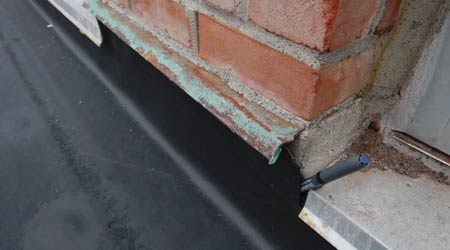 All flashings should be inspected to ensure they are properly sealed and are free of voids, punctures, and blisters, and that there are no open laps.Structuretec
All flashings should be inspected to ensure they are properly sealed and are free of voids, punctures, and blisters, and that there are no open laps.StructuretecHow To Inspect and Evaluate Roofing Membrane Conditions
Do a strict audit of all components of the roof, including perimeter edges, copings, base flashings, counterflashings, and area dividers.
A primary focus of the roofing evaluation should be membrane conditions. The roofing membrane is the weatherproofing layer to keep the elements out of the building. The two primary types are built-up systems and single-ply systems. Built-up systems are constructed with multiple plies of a felt material, then saturated with coal tar pitch or hot asphalt. The benefit of a built-up roof system is the redundancy, with multiple plies of weatherproofing protection. Typical conditions seen within a built-up system are blisters which indicate entrapped moisture in the roofing system, alligatoring of the membrane, voids which could be caused by lack of bitumen within the plies, and bare or exposed felts.
The most common single-ply roofing systems are EPDM (synthetic rubber), TPO, and PVC membranes, the latter two both thermoplastics. In single-ply roofing systems, be very cautious of membrane deficiencies because there is only one layer of protection. Typical conditions that affect the various single-ply systems are open lap seams, thermal membrane shrinkage with EPDM membrane, and plasticizer migration within PVC and TPO systems which causes brittleness of the membrane. Fastener back-out and punctures in the membrane are also typical deficiencies of mechanically attached single-ply systems.
There should be a strict audit of all components such as perimeter edges, copings, base flashings, counterflashings, and area dividers. Areas such as these require a high attention to detail during construction and tend to become problematic as time passes. All flashings should be inspected to ensure they are properly sealed and are free of voids, punctures, and blisters, and that there are no open laps. Sealants should be inspected for voids and deterioration at every coping joint and coping end. Termination bars and counterflashings should also be inspected to evaluate current conditions. Make sure to inspect flashing and sealant conditions around every penetration, rooftop unit, skylight, and other projection.
Drains, scuppers, and gutters should be inspected to ensure that water has a route to exit the roof. On a typical low-slope or “flat” roof system, it is recommended that the roof have no less than one quarter inch per foot slope to drain to allow adequate drainage. Signs of inadequate drainage include standing or ponding water on the roof surface. Staining on the roof surface is an indication of ponding water conditions. All drains should be inspected and cleaned of any debris, and all drain strainers and bolts should be present and tight. Drains should also be inspected for adequate flashing and sealants. Scuppers and gutters should be examined to ensure that they are free of debris, properly flashed, and sealed. Adequate drainage plays a key role in the longevity of the roofing system, preventing water from standing on the roof.
The transitions at the roof to wall interface tie-ins tend to be particularly problematic. These include parapets, penthouse walls, and the walls at the roof line. It’s easy to attribute water leakage to the roof system and make roof repairs when the water is actually entering into the wall.
Take action
Taking inventory of an organization’s roofs and examining each detail is a crucial process that can be quite time consuming. What is done with the information gathered is just as important as the data collected. To get the best return on the roof evaluation, a facility manager needs a systematic approach for processing and using the information that’s been assembled. The best way to do this is separating roof areas into three categories. In the good category are roofs that are in good to excellent condition, with all minor deficiencies addressed. The second category includes all roof areas that are in poor condition or have failed, and are in need of full replacement. The final category is for roofs that are in fair condition or near the midpoint of their lives. Roofs in this category should be given special attention as they may be candidates for strategic repairs or restoration, allowing the facility manager to double the life of the asset for a minimal cost.
Knowing the importance a roof system plays in protecting facility assets and everything within them, it is critical to understand the locations, root causes, and solutions to the most common roof problems. Using this data proactively will allow the facility manager to take action and remediate roof problems before they become major, costly, and time-consuming projects.
Nicholas J. O’Hare (nick.ohare@structuretec.com), quality manager at StructureTec, focuses on understanding customer needs and designing solutions to meet those needs. He has been involved in managing roofing, building envelope, and paving projects in the corporate, K-12, higher education, and health care industries.
Email comments to edward.sullivan@tradepress.com.
Related Topics:














